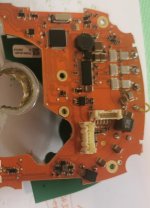Hi,
Sorry for highjacking the topic. First-thank you for it. It is a great resource for people with problematic motors, that want to salvage their systems. I found this topic while researching what kind of controller should I buy for my problematic freewheel Impulse EVO RS system on a Focus Thron ebike 250w 25km/h 92Nm 630Wh. The bike had several downtimes for its 2600km life, primarily software ones and torque sensor ones but it's still running and in pristine condition-bike parts are great and rides great, battery is still 100% healthy and has great range, motor is mechanically looking great-no broken freewheel paws, no bad bearings, no water ingress, gears are not stripped etc. The problem that I cannot resolve is with the power delivery. For the last 700km you have to press hard in order to get going and keep low cadance and pressure on the pedals to get good power from the bike. The power delivery bar (it has one) rarely goes over the middle, in the past it reached the top at steep hills. So, I am not a total electronics noob, but the logic board of the motor is way over my level of expertise. It looks very well made but it is full with tiny components that are lacquered for water proofing and it is imposible for me to check any components, besides the 2 capacitors, which seem in pristine condition (measured with an ESR meter).
So the torque sensor is the same as you described your Boch's one, but some proprietary make of Derby Darum company and no way to source a replacemnt. It is a cylindrical one placed between the cranks' axle and the freewheel that engages to the main big metal gear. It has three wires- White, Brown and Green. When removed I can only read resistance between leads-15,5ohm WtoB;15,5ohm WtoG;30ohm BtoG. I can't see how it could be broken. There is not a lot to break there. There is a small hall sensor, or inductive sensor on the Main big metal gear that basically should read the forward rpms of the cranks, after the freewheel. It also has three leads. The middle one is Ground and I should measure the rest while powered on.
So I want to fix the bike since ever, bit since it is this closed system without any support in my country I am now planning to bypass its controller and use an external one as you did. I was planning of using a cheap Chinese sensorless one, as there are no hall sensors on the motor at all and use a thumb trottle plus keeping the original board for communicating to the battery, so that I don't need to swap the BMS, then I read your post and now I am considering bying a good controller as you did, so I could have better flexibility and possibly re-use the torque sensor, instead of thumb trottle, if the problem is outside of it. I would probably have to open a new topic, but initiall advices are welcome.






